

Infrared-ultrasonic beacon system. 12.
En.myinventions.pl - blender, arduino, processing, 3d scanning. Ultrasonic (Ultrasound) Electronic Circuits. Kiris2004.pdf (application/pdf Object) My Research - DistanceSensor. The gadget performs its functions, but it should be handled with caution.
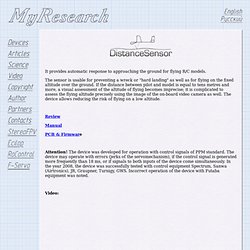
I used to fly high and carefully without the gadget; I started to fly low and at risk, after having installed the gadget; besides, the accidents occur. 1. Servomechanism of the elevator for models of planes and gliders. It is the main scheme of connection for winged aircraft models. Operation of the device is effective both in the repulsion (saving) mode and the altitude holding mode. Distance measurement with radio waves. Introduction: First of all, we want to excuse us for our bad English.
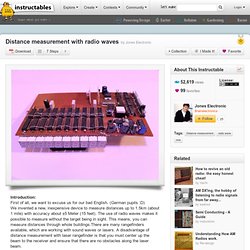
(German pupils :D) We invented a new, inexpensive device to measure distances up to 1.5km (about 1 mile) with accuracy about ±5 Meter (15 feet). The use of radio waves makes it possible to measure without the target being in sight. This means, you can measure distances through whole buildings.There are many rangefinders available, which are working with sound waves or lasers.
A disadvantage of distance measurement with laser rangefinder is that you must center up the beam to the receiver and ensure that there are no obstacles along the laser beam. Schematics and layouts are 100% own work, no copy and paste, only the transmitter and receiver modules had been bought.We already took part with this project in a German youth science competition called „Jugend-Forscht“ and won the 1st prize. Step 1: Basic idea To put it simply, the main part is an exact stopwatch, which measures time with a resolution in nanoseconds. ChrisFenton.com. This device was created in a hurry for the USC Rocket Propulsion Lab, the student-run high-altitude rocketry effort at USC.

I think I soldered it together a day or two before the launch, and then programmed it on a laptop on the car trip out to the desert. It uses a Picaxe 18X microcontroller and accepts a GPS NMEA data stream at 4800 baud (I think?). It pulls out the altitude and logs it to a 24LC512 external EEPROM, and then reads it back when you are done. Here is a full schematic for it: I unfortunately do not have any pictures of the board, but it was pretty simple. Radio Telemetry for a Model Rocket. Flying model rockets is fun, but there is always the question of how high did it go.
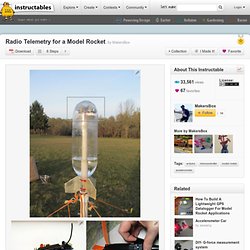
Using a programmable micro-controller and some sensors, you can monitor the entire phase of flight and measure acceleration and altitude, among other things. With this project, I’ll show you how I did just that, using off-the-shelf open source hardware and software to build an Arduino compatible flight telemetry system. Model rocketry telemetry is nothing new. Amateurs have been stuffing electronics in rockets since the beginning of the hobby. A programmable micro-controller coupled with a low-power radio, however, allows us to take the hobby to a whole new level. If you haven't heard of Arduino yet, or if you are rolling your eyes at "yet another Arduino project", you should read Phillip Torrone's take on it and his prediction that "within the next 5 to 10 years, the Arduino will be used in every school to teach electronics and physical computing.
" Hacking Automotive Ultrasonic Sensors. This instructable will show you how to hack / reuse a common Bosch automotive ultrasonic sensor(s).
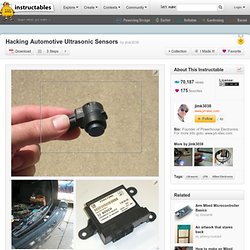
The sensor in this instructable is a very common sensor that can be found in junkyards all over the world. The hope is that this information will allow folks to reuse these sensors in wonderful new applications. There are many advantages to using automotive ultrasonic sensors. Easily detect objects within a two meter range. Detect multiple objects within the sensor's field of view. A Sensitive DIY Ultrasonic Range Sensor. I needed some ultrasonic range finders for my project.
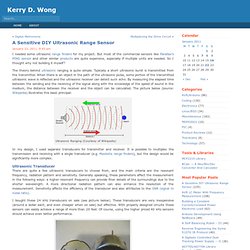
But most of the commercial sensors like Parallax’s PING sensor and other similar products are quite expensive, especially if multiple units are needed. So I thought why not building it myself? The theory behind ultrasonic ranging is quite simple. Laser Range Finder Build - Hacked Gadgets - DIY Tech Blog. Joe Grand who you might remember from Prototype This has been working on a Laser Range Finder, he has been nice enough to share his build issues and successes over at the Parallax Forums.
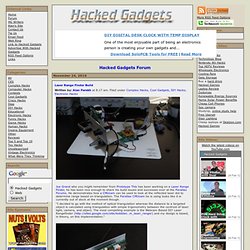
He demonstrates how a CMUcam can be used to look at the reflected laser dot to determine range based on triangulation. The Parallax CMUcam he is using looks like it is currently out of stock at the moment though. “I decided to go with the method of optical triangulation whereas the distance to a targeted object is calculated using triangulation with simple trigonometry between the centroid of laser light, camera, and object. Webcam Based DIY Laser Rangefinder - Todd Danko. There are many off the shelf range finding components available including ultrasonic, infrared, and even laser rangefinders.
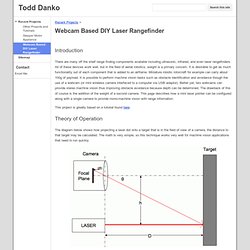
All of these devices work well, but in the field of aerial robotics, weight is a primary concern. It is desirable to get as much functionality out of each component that is added to an airframe. Miniature robotic rotorcraft for example can carry about 100g of payload. It is possible to perform machine vision tasks such as obstacle identification and avoidance though the use of a webcam (or mini wireless camera interfaced to a computer via USB adaptor). Better yet, two webcams can provide stereo machine vision thus improving obstacle avoidance because depth can be determined. Infrared-ultrasonic beacon system. Choosing an Ultrasonic Sensor for Proximity or Distance Measurement Part 1: Acoustic Considerations. February 1, 1999By: Donald P.
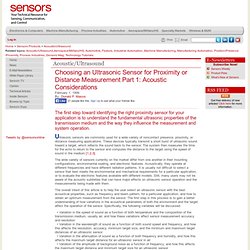
Massa The first step toward identifying the right proximity sensor for your application is to understand the fundamental ultrasonic properties of the transmission medium and the way they influence the measurement and system operation. Ultrasonic sensors are commonly used for a wide variety of noncontact presence, proximity, or distance measuring applications. These devices typically transmit a short burst of ultrasonic sound toward a target, which reflects the sound back to the sensor.